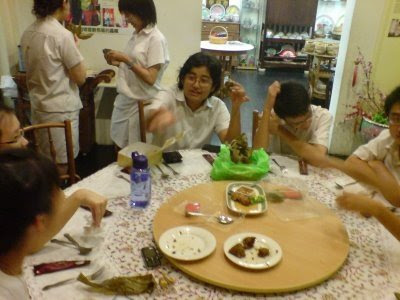




.jpg)
.jpg)
The Peranakans have long been part of Singapore’s complex cultural landscape, with their colorful heritage and acculturation of Chinese and Malay traditions. This marriage of traditions gave birth to new customs and beliefs, unique practices and diverse cuisines.
The term Peranakan in Malay literally translates as ”descendants”, and was used to describe offspring of local Malay women and Chinese businessmen who had settled in the Straits Settlement and Malay Archipelagos during the 19th century.
More specifically, male descendants were called Babas and female descendants Nonyas while senior females were recognized as Bibiks.
Most of these descendants, although retaining their Chinese beliefs, also adopted local indigenous lifestyle. Thus, giving birth to the unique practices of the Peranakans and even their own variation of the Malay language called Baba Malay.
Customs
A large part of peranakan customs comes from traditional beliefs inherited from their Chinese ancestors. Their strict observance to these beliefs sometimes supplants even the Chinese themselves.
The family unit is an important facet of the Peranakans, and family members within the same tree can usually be found living under one roof much like their Chinese counterparts.
Nevertheless, the true feature that defines the Peranakans is their ability to embrace modern thinking. For instance, unlike the traditional Chinese who in the past, favored male offspring, Peranakans deemed both sons and daughters equal rights to the family fortune.
Thrills for the Taste Buds
Peranakan food is probably the most diverse and distinctive of all local cuisines. A marriage of cooking styles, Nonya cuisines combine the preparation techniques of both traditional Chinese and Malay cooking.
This unusual marriage gives Nonya cuisine its distinctive taste, filled with exciting flavors from the use of local herbs and spices, and more often than not spicier and hotter than Chinese food.
A typical Nonya kitchen would not be without condiments like tumeric, ginger, galangal, shallots, chives and shrimp paste. Lemon, limes, tamarinds, green mangoes, citrus leaves and coconut milk are also used to up the epicurean experience.
Blend it like the peranakans
Rempah, an exciting blend of ingredients pounded together in a mortar and cooked in oil to release its flavor is used for a variety of dished. It’s this special combination that sets Peranakan food apart from the rest.
And because of their ingenuity to improvise traditional dishes with spices and herbs, Peranakans have produced tasty local treats like achar, curry fish in banana leaves, satay babi goring, buah keluak, chendol, nonya kuehs and many other delights.
Why Nonya Dumplings are Different from Other Dumplings?
Traditionally, Nonya cuisine is a fusion of Chinese and Malay influences and quite often draws inspiration from both its techniques and use of key ingredients and spices. The Nonya Dumpling is no exception to this rule and is one of many unique culinary delights interpreted from a time- honored Chinese cuisine.
Here are a few distinctive ways to tell the two apart. For instance, the Nonya-interpretation uses fragrant pandan leaves to wrap the dumpling instead of bamboo sections.
And while Chinese dumplings are filled with fatty pork fillings, Nonya dumplings usually contain seasoned minced pork and sliced winter melon cubes.
But what truly sets them apart is the unique taste found within each nonya dumpling, which employs a complete range of local condiments to give a fulfilling taste experience.
Blue coloring is sometimes added to give the dumpling a sweetened tang and a distinct look, courtesy of the essence found in blue pea flower or bunga telang.


No comments:
Post a Comment